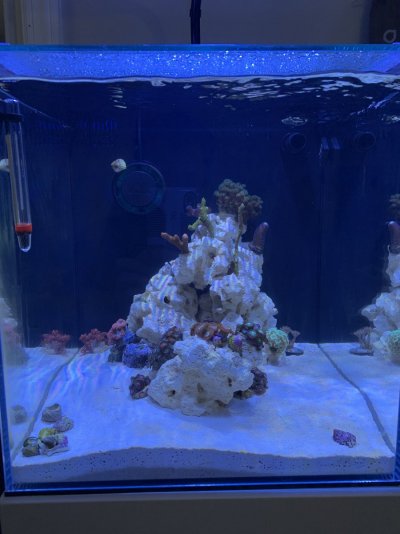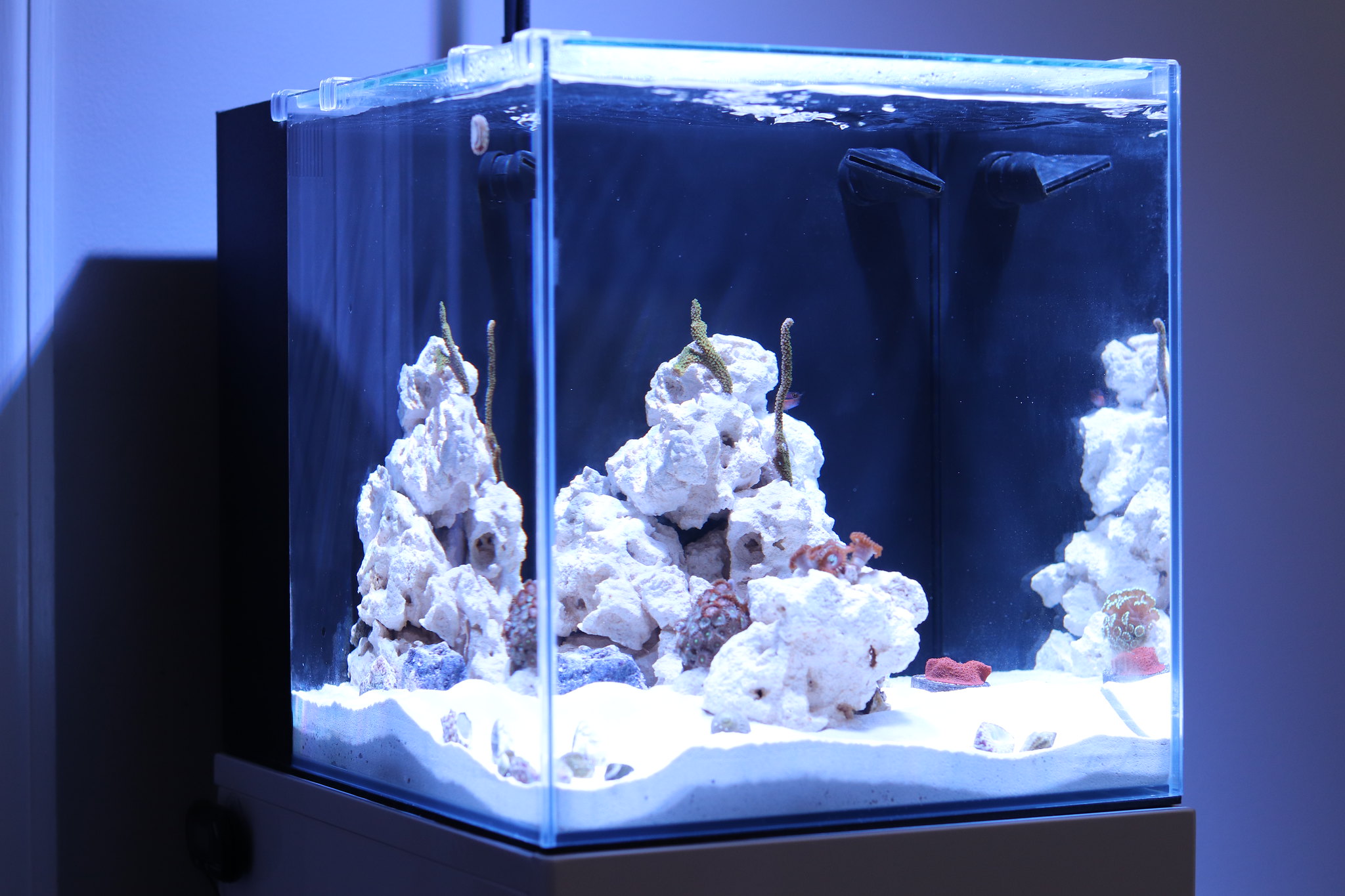I'm hoping to get some help regarding a sudden incident in my tank, which appears to possibly have caused a bacterial/algal bloom, which made the water slightly cloudy and caused an increase in nitrites. I have an AIO 10G cube, with a few coral frags, 2 peppermint shrimp, 3 dwarf hermit crabs, 2 trochus snails, and 1 tailspot blenny. I run a media rack in the first chamber that only has live rock rubble in a media bag and then filter floss up top by the overflow. In the 2nd chamber I have chaeto growing, and another small media bag of live rock rubble.
Right now my nitrites are testing at .25ppm, while ammonia is 0ppm, nitrates are 4.74ppm, and phosphates are .22ppm.
I believe things started progressing on Saturday, which was when I believe I overfed my tank by a large margin, but I'm not sure if that caused the problem, or just compounded it. The thing is, for a while my phosphates and nitrates were undetectable, so I had started playing around with providing less light to the chaeto in the back chamber, and then feeding heavier. I cut down the light to only 2 hours, and on top of feeding the tailspot blenny frozen spirulina, I spot fed all of the coral reef roids(only 3 times per week). On Saturday, it seemed like maybe I fed too much, because it just seemed like a lot and some of the coral started looking ticked off. Later in the day is when I started noticing that the water seemed a bit cloudy. I tested for ammonia/nitrites/nitrates/phosphates, and while ammonia/nitrites came back as 0, nitrates tested 4.73ppm and phosphates tested .22ppm. I thought that was a bit crazy because just a day or two ago, my phosphates were still reading 0.
Sunday comes along, and the water looks more cloudy, most coral is irritated at this point, with the exception of a couple frags looking unaffected. The snails, hermits, peppermint shrimp, and tailspot were all doing their normal thing, none of them seemed stressed. So I decided I could be proactive, and I swapped out all of the old filter floss for new pieces, and threw in a bag of activated carbon. I should also note that I had a mushroom that was hating life in the display migrate itself to the back chambers where there isn't any light(it squeezed itself through one of the two holes in the false wall designed to keep the water level even). It had made its way to the 2nd chamber, so I had to pull out all of the chaeto and the bag of rubble to get it out.
So I finish all of the maintenance, and leave the tank alone. Fast forward a few hours and I go to test ammonia/nitrite again at 8PM. This time, ammonia comes back as what looks to be 0, but nitrites definitely tested at .25ppm. In anger, I did a 40% water change and then left the tank alone for the night thinking everything would probably be back to normal in the morning. However it was not. I tested the water again around 8AM, and ammonia was 0, but nitrites still read at .25ppm. I thought maybe it was a false reading so I tested a fresh batch of saltwater I had put in to mix overnight and it tested as 0ppm, so obviously the test kit isn't giving false readings.
I'm trying to figure out if I did in fact overfeed and cause a bacterial bloom, but I don't really know much about blooms in general. This is the first time this has ever happened to me in my ~10 years of reefing, granted, this is my first go at a < 10Gallon system. I've always had systems with sumps prior to this aquarium.
I also don't really know how to combat this... Did I kill my nitrifying bacteria population by doing this? Or perhaps did this happen because removing all of that filter floss removed a significant portion of my nitrifying bacteria? Do I keep doing water changes until nitrites test 0, or do I just wait it out and let it all convert to nitrates, then do a water change?
I would also like to mention that this tank was fully cycled about a month ago, so it's about a month old, give or take a couple days.
I appreciate any and all help, and apologize for the wall of text. I just really would prefer not to lose any livestock or this. Thank you!
Right now my nitrites are testing at .25ppm, while ammonia is 0ppm, nitrates are 4.74ppm, and phosphates are .22ppm.
I believe things started progressing on Saturday, which was when I believe I overfed my tank by a large margin, but I'm not sure if that caused the problem, or just compounded it. The thing is, for a while my phosphates and nitrates were undetectable, so I had started playing around with providing less light to the chaeto in the back chamber, and then feeding heavier. I cut down the light to only 2 hours, and on top of feeding the tailspot blenny frozen spirulina, I spot fed all of the coral reef roids(only 3 times per week). On Saturday, it seemed like maybe I fed too much, because it just seemed like a lot and some of the coral started looking ticked off. Later in the day is when I started noticing that the water seemed a bit cloudy. I tested for ammonia/nitrites/nitrates/phosphates, and while ammonia/nitrites came back as 0, nitrates tested 4.73ppm and phosphates tested .22ppm. I thought that was a bit crazy because just a day or two ago, my phosphates were still reading 0.
Sunday comes along, and the water looks more cloudy, most coral is irritated at this point, with the exception of a couple frags looking unaffected. The snails, hermits, peppermint shrimp, and tailspot were all doing their normal thing, none of them seemed stressed. So I decided I could be proactive, and I swapped out all of the old filter floss for new pieces, and threw in a bag of activated carbon. I should also note that I had a mushroom that was hating life in the display migrate itself to the back chambers where there isn't any light(it squeezed itself through one of the two holes in the false wall designed to keep the water level even). It had made its way to the 2nd chamber, so I had to pull out all of the chaeto and the bag of rubble to get it out.
So I finish all of the maintenance, and leave the tank alone. Fast forward a few hours and I go to test ammonia/nitrite again at 8PM. This time, ammonia comes back as what looks to be 0, but nitrites definitely tested at .25ppm. In anger, I did a 40% water change and then left the tank alone for the night thinking everything would probably be back to normal in the morning. However it was not. I tested the water again around 8AM, and ammonia was 0, but nitrites still read at .25ppm. I thought maybe it was a false reading so I tested a fresh batch of saltwater I had put in to mix overnight and it tested as 0ppm, so obviously the test kit isn't giving false readings.
I'm trying to figure out if I did in fact overfeed and cause a bacterial bloom, but I don't really know much about blooms in general. This is the first time this has ever happened to me in my ~10 years of reefing, granted, this is my first go at a < 10Gallon system. I've always had systems with sumps prior to this aquarium.
I also don't really know how to combat this... Did I kill my nitrifying bacteria population by doing this? Or perhaps did this happen because removing all of that filter floss removed a significant portion of my nitrifying bacteria? Do I keep doing water changes until nitrites test 0, or do I just wait it out and let it all convert to nitrates, then do a water change?
I would also like to mention that this tank was fully cycled about a month ago, so it's about a month old, give or take a couple days.
I appreciate any and all help, and apologize for the wall of text. I just really would prefer not to lose any livestock or this. Thank you!





















